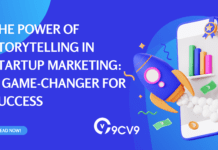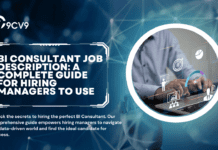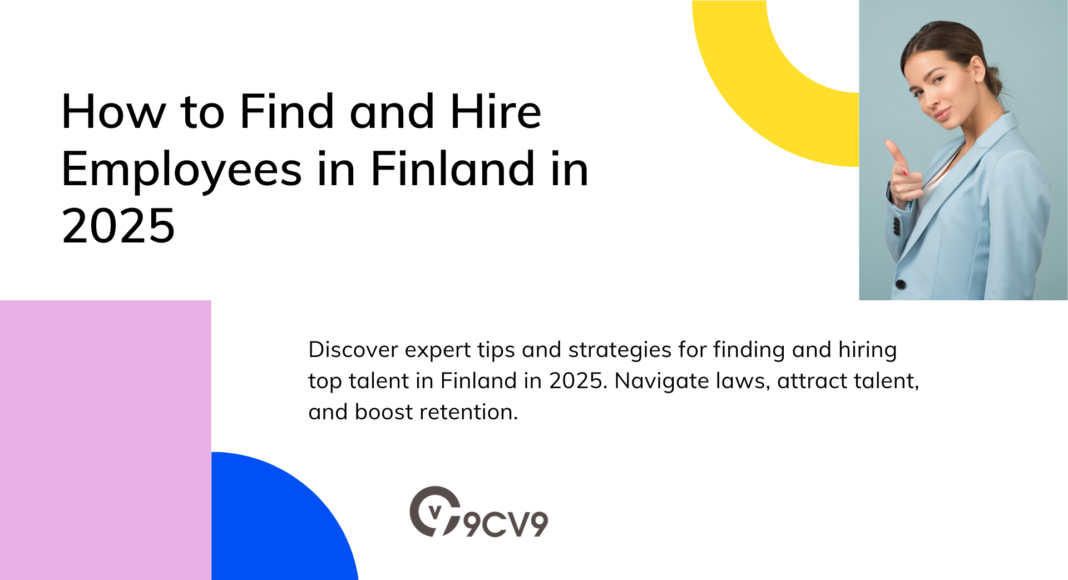Key Takeaways
- Understanding Finland’s labor laws and cultural norms is crucial for compliant and effective hiring in 2025.
- Leveraging tools like the 9cv9 Job Portal and recruitment agencies streamlines the hiring process and connects employers to top talent.
- Offering competitive benefits, flexible work options, and strong onboarding programs ensures employee retention and satisfaction.
As businesses across the globe continue to adapt to an ever-changing economic landscape, hiring talent in foreign markets has become a crucial strategy for expansion and sustainability.
Finland, with its highly educated workforce, advanced digital infrastructure, and progressive labor market policies, offers immense opportunities for employers looking to expand their talent pool in 2025.
However, understanding the nuances of finding and hiring employees in Finland requires a comprehensive approach that considers not only the legal and cultural aspects of recruitment but also the evolving trends and expectations of Finnish job seekers.

In recent years, Finland has become one of the leading countries in the European Union for innovation, technology, and sustainability.
By 2025, Finland’s job market is expected to undergo significant transformations, driven by advancements in automation, artificial intelligence (AI), and digitalization.
Sectors such as technology, engineering, healthcare, and renewable energy are projected to remain at the forefront of job demand, making Finland an attractive destination for businesses seeking specialized talent.
Moreover, Finland’s strong emphasis on work-life balance, employee well-being, and workplace equality continues to attract top professionals both locally and from abroad.
However, the hiring process in Finland is not without its challenges.
Understanding Finland’s strict employment laws, navigating the complexities of work permits for international candidates, and accommodating the country’s preference for bilingual or multilingual workers can be daunting for foreign employers.
Additionally, recruitment practices in Finland place a significant emphasis on cultural fit, making it essential for businesses to develop strategies that appeal to the values and expectations of Finnish job seekers.
With its robust labor protections and commitment to fair practices, Finland offers a well-regulated hiring environment, but employers must be well-versed in its legal framework to ensure compliance.
For those looking to hire in Finland in 2025, the process begins with a thorough understanding of the local job market, which continues to evolve in response to economic shifts, technological advancements, and changing societal expectations.
Job seekers in Finland are increasingly looking for employers who offer flexibility, career growth, and a healthy work-life balance.
As remote work and hybrid working models grow in popularity, employers must also be prepared to adapt their recruitment strategies to attract top talent in this new, more dynamic employment landscape.
This blog will guide you through the comprehensive steps to successfully find and hire employees in Finland in 2025.
From understanding the local labor market trends to navigating legal regulations, we’ll explore the best practices for recruiting in Finland, how to effectively attract top talent, and the essential strategies for onboarding and retaining employees.
Whether you’re a local company expanding your workforce or an international organization considering Finland as a new recruitment hub, this guide will provide the knowledge you need to build a successful hiring strategy in one of the most competitive job markets in Europe.
With the right knowledge and preparation, hiring in Finland can be a highly rewarding experience, enabling your business to tap into a pool of highly skilled professionals committed to excellence and innovation.
Let’s dive into the essential steps and strategies for finding and hiring employees in Finland in 2025.
Before we venture further into this article, we would like to share who we are and what we do.
About 9cv9
9cv9 is a business tech startup based in Singapore and Asia, with a strong presence all over the world.
With over nine years of startup and business experience, and being highly involved in connecting with thousands of companies and startups, the 9cv9 team has listed some important learning points in this overview of the Top 10 Best Bug Tracking Software To Use in 2025.
If your company needs recruitment and headhunting services to hire top-quality employees, you can use 9cv9 headhunting and recruitment services to hire top talents and candidates. Find out more here, or send over an email to [email protected].
Or just post 1 free job posting here at 9cv9 Hiring Portal in under 10 minutes.
How to Find and Hire Employees in Finland in 2025
- Understanding the Finnish Job Market in 2025
- Key Hiring Regulations and Legal Considerations in Finland
- How to Find Talent in Finland
- Steps to Attract Top Talent in Finland
- The Interview and Selection Process in Finland
- Onboarding and Retention Strategies for Finnish Employees
- Challenges and Considerations for Hiring in Finland in 2025
1. Understanding the Finnish Job Market in 2025
In 2025, the Finnish job market is poised to undergo significant transformations, driven by a combination of technological advancements, demographic shifts, and evolving worker expectations. Whether you’re a foreign employer or a local business, gaining an in-depth understanding of the current and emerging trends in Finland’s labor market is crucial for successful recruitment. Below, we break down key factors shaping the Finnish job market in 2025.
Economic Landscape and Workforce Trends in 2025
- Technological Transformation:
- Finland’s workforce is increasingly influenced by technological advancements such as automation, AI, and digitalization.
- Example: Sectors like software development, data analytics, and cybersecurity are experiencing a significant demand for skilled professionals, especially as Finnish companies integrate AI-driven tools into their operations.
- Impact: The rise of tech-centric industries has created a pressing need for upskilling and reskilling workers to meet the demands of emerging technologies.
- Aging Population and Workforce Shrinking:
- Finland, like many other European countries, is grappling with an aging population. The country’s birth rate remains low, while the proportion of retirees continues to rise.
- Example: This demographic trend has led to skill shortages in several key industries, particularly in healthcare, social services, and engineering.
- Impact: Employers are increasingly focusing on attracting younger talent and immigrants to offset these labor shortages.
- Shift to Remote and Hybrid Work:
- The COVID-19 pandemic accelerated Finland’s shift towards remote and hybrid work models, a trend expected to persist in 2025.
- Example: Companies such as Nokia and Supercell are embracing hybrid working environments, allowing employees to split their time between home and the office.
- Impact: Job seekers in Finland are placing a premium on work-life balance and flexible job offerings. This shift has expanded recruitment opportunities beyond the major cities to more rural areas.
High-Demand Sectors and Roles in Finland
- Technology and IT Sector:
- Software Development: With Finland’s growing tech ecosystem, there is a high demand for software engineers, especially in areas like cloud computing, AI, and machine learning.
- Example: Finland is home to major tech players like Rovio Entertainment and Wolt, both of which have expanded their talent pools globally due to a shortage of local software development professionals.
- Cybersecurity: As digital transformation accelerates, cybersecurity professionals are in high demand to safeguard companies against increasing cyber threats.
- Healthcare and Social Services:
- Nurses and Healthcare Professionals: Due to an aging population, healthcare workers are in significant demand, particularly for eldercare and specialized medical roles.
- Example: Finnish hospitals and care homes are increasingly looking to hire foreign professionals to meet the growing healthcare needs.
- Impact: There is a pressing need for both skilled medical professionals and support staff to cater to the elderly population.
- Engineering and Manufacturing:
- Mechanical and Electrical Engineers: Finland’s strong manufacturing and engineering sector is always in need of highly skilled engineers for everything from renewable energy projects to industrial automation.
- Example: Finnish companies like KONE and Wärtsilä are consistently looking for talented engineers to drive innovations in elevator systems and energy solutions.
- Impact: Highly technical roles such as systems engineers, robotics specialists, and automation engineers are expected to see a surge in demand.
- Renewable Energy:
- Sustainability Roles: Finland’s commitment to sustainability is evident in the expansion of its renewable energy sector. As a result, jobs related to wind energy, solar power, and green construction are on the rise.
- Example: Companies like Fortum and Neste are expanding their operations in green energy, requiring a new generation of sustainability experts and engineers.
- Impact: There will be continued demand for professionals who can support Finland’s green energy transition, particularly in roles such as environmental consultants, energy analysts, and green building designers.
Key Skills in Demand in 2025
- Tech and Digital Skills:
- As Finland’s economy becomes more digitized, the demand for digital skills continues to increase across industries.
- Example: Finland is home to an expanding tech start-up ecosystem, which frequently requires talent with experience in full-stack development, cloud computing, and AI programming.
- Impact: Job seekers with expertise in emerging technologies, coding languages, and data analytics are in high demand.
- Bilingual or Multilingual Professionals:
- Finland’s diverse business environment means that fluency in Finnish, Swedish, and English is often required, especially for customer-facing roles.
- Example: Finnish multinational companies like KONE and Vaisala actively recruit employees who are fluent in multiple languages to ensure they can communicate effectively across global markets.
- Impact: Bilingual candidates are highly sought after in Finland, particularly for roles in customer service, marketing, and sales.
- Soft Skills and Interpersonal Abilities:
- Finnish employers are placing increasing value on soft skills such as problem-solving, adaptability, and effective communication. These skills are seen as essential in a highly collaborative work culture.
- Example: Start-ups and tech companies often value teamwork and creative thinking as much as technical expertise.
- Impact: Professionals who possess a combination of technical expertise and strong interpersonal skills are highly competitive in the Finnish job market.
Trends in the Finnish Workforce and Recruitment Strategies
- Employee Well-being and Work-Life Balance:
- Finland is renowned for its focus on work-life balance, which remains a top priority for Finnish workers.
- Example: The Finnish government offers several social benefits, such as paid parental leave and flexible working arrangements, which have set a high standard for employers.
- Impact: Companies that offer remote work options, flexible hours, and a strong emphasis on mental health and well-being are more likely to attract top talent.
- International Talent and Immigration:
- To address labor shortages in key industries, Finland is actively encouraging skilled immigration.
- Example: Programs like the “Finnish Immigration Hub” are designed to attract foreign professionals to fill high-demand roles, especially in healthcare, technology, and engineering.
- Impact: Employers looking to expand their talent pools can benefit from Finland’s welcoming policies toward skilled immigrants.
Government Policies and Employment Legislation
- Employee Rights and Benefits:
- Finland has a strong legal framework for employee protection, including extensive rights for workers in terms of pay, benefits, and workplace conditions.
- Example: Finnish workers are entitled to several weeks of paid vacation, healthcare, and parental leave, which contribute to high employee satisfaction and retention.
- Impact: Employers must navigate these legal requirements to ensure they offer competitive and legally compliant benefits packages.
- Focus on Gender Equality and Inclusivity:
- Finland continues to be a leader in gender equality, with a strong focus on ensuring equal opportunities in the workplace.
- Example: Finland has one of the highest female participation rates in the workforce, and many companies implement gender-neutral hiring practices.
- Impact: Employers who prioritize inclusivity and diversity not only benefit from a larger talent pool but also align with Finland’s progressive values, which are essential for attracting top-tier candidates.
This section provides a comprehensive analysis of the key factors shaping the Finnish job market in 2025, from technological shifts to the evolving needs of the workforce. By focusing on high-demand sectors, in-demand skills, and the latest trends in employment, it offers practical insights for employers looking to find and hire the best talent in Finland.
2. Key Hiring Regulations and Legal Considerations in Finland
When hiring employees in Finland in 2025, understanding the country’s legal framework is essential to ensure compliance with labor laws and maintain a fair, transparent hiring process. Finland has a well-regulated employment environment that prioritizes employee rights, workplace safety, and equitable opportunities. Whether you’re a local business or a foreign employer looking to establish a presence in Finland, being well-versed in the key hiring regulations will help you navigate the recruitment process more efficiently. Below, we outline the critical legal considerations you must keep in mind when hiring employees in Finland.
Employment Contracts and Terms of Employment
- Written Employment Contracts:
- Finnish law mandates that all employment contracts must be in writing, and both parties (employer and employee) must sign them.
- Example: Employment contracts should outline the job description, compensation, working hours, duration of employment (if temporary), and probation period, if applicable.
- Impact: Failure to provide a written contract may lead to disputes over employment terms, which could result in legal complications.
- Probation Period:
- A probationary period of up to 6 months is commonly used to assess an employee’s suitability for a role. During this period, both the employer and employee can terminate the contract with shorter notice periods.
- Example: In a software development role, an employer may choose a 3-month probation period to assess the technical proficiency and cultural fit of the employee before offering permanent employment.
- Impact: Ensure clear communication of the probation terms in the contract to avoid misunderstandings about job expectations.
- Temporary and Fixed-Term Contracts:
- Fixed-term contracts are legal in Finland but must be justified with valid reasons (e.g., seasonal work or project-based work). Employers must also ensure that the contract is renewed or converted into a permanent one when appropriate.
- Example: A company hiring employees for a 1-year project in AI research must specify the project’s duration in the contract and provide clear reasoning for the fixed term.
- Impact: Misuse of fixed-term contracts (e.g., repeatedly renewing them without a valid reason) can lead to permanent employment rights being automatically granted.
Equal Employment Opportunity and Anti-Discrimination Laws
- Non-Discrimination Principles:
- Finland’s employment laws strongly emphasize equality in the hiring process. Discrimination based on gender, age, ethnicity, disability, sexual orientation, or religion is strictly prohibited.
- Example: Employers cannot make hiring decisions based on the applicant’s marital status or pregnancy, as such actions are considered discriminatory under Finnish law.
- Impact: Employers must ensure that their recruitment policies and practices are inclusive and free of bias to avoid legal consequences and reputational damage.
- Gender Equality:
- Finland is a global leader in gender equality, and the Gender Equality Act mandates that employers promote equal treatment in the workplace.
- Example: Companies in Finland are legally required to conduct gender pay gap audits and take action to correct any disparities between male and female employees in similar roles.
- Impact: Employers need to provide equal opportunities for career development and remuneration across gender lines to comply with Finnish equality laws.
- Disability and Inclusion:
- Finnish law also emphasizes the inclusion of people with disabilities in the workforce. Employers are encouraged to make reasonable accommodations for employees with disabilities.
- Example: A company hiring a marketing professional must provide accessibility adjustments (e.g., accessible workspaces, assistive technologies) for employees with disabilities.
- Impact: Discriminating against people with disabilities or failing to make reasonable accommodations may result in legal action and fines.
Worker’s Rights and Benefits
- Minimum Wage and Salary Regulations:
- Although Finland does not have a national minimum wage, collective agreements (often industry-specific) set the minimum pay levels. Employers must ensure they meet these standards.
- Example: In Finland’s healthcare sector, collective bargaining agreements establish salary structures based on the employee’s job role and years of experience.
- Impact: Employers who fail to adhere to industry-specific salary agreements risk breaching labor laws and facing legal consequences.
- Working Hours and Overtime:
- The Finnish Working Hours Act establishes that employees should work no more than 40 hours per week. Overtime is allowed but must be compensated at a higher rate (usually 1.5x the normal rate).
- Example: An employee working in a sales role for a Finnish company may be required to work overtime to meet quarterly targets, which must be compensated according to the law.
- Impact: Employers must be vigilant in tracking working hours and overtime to ensure compliance with Finnish labor laws and avoid disputes.
- Annual Leave and Paid Time Off:
- Finnish workers are entitled to annual paid vacation, generally around 30 days per year. Employers must ensure employees take their leave and receive compensation for unused vacation time upon termination.
- Example: A senior manager in a Finnish company who worked for one year must be granted at least 30 days of paid vacation.
- Impact: Failure to grant annual leave or compensate employees for unused vacation time can result in legal repercussions and fines.
Termination of Employment
- Termination Procedures:
- Finnish law requires employers to follow a strict process when terminating an employee, including providing notice periods and justifiable reasons for dismissal.
- Example: If an employee’s performance is inadequate, the employer must document the performance issues and provide support to improve the situation before proceeding with dismissal.
- Impact: Employers must ensure that terminations are conducted fairly and in line with the law, including following notice periods (typically 14 to 30 days depending on tenure).
- Redundancy and Layoffs:
- Employers must comply with specific regulations if they wish to lay off employees due to business reasons, such as financial difficulties or restructuring. Affected employees are often entitled to severance pay or compensation.
- Example: In the event of a company downsizing, Finnish law requires that employees are consulted in advance and offered suitable alternative roles where possible.
- Impact: Employers must be aware of the legal rights of employees during redundancy processes to avoid legal disputes.
Health and Safety Regulations
- Workplace Safety:
- Finnish employers must comply with strict health and safety regulations to ensure that employees are working in safe conditions. This includes providing necessary equipment and training.
- Example: A construction company must provide protective equipment, such as helmets and gloves, and ensure all workers are trained in safety procedures.
- Impact: Non-compliance with health and safety regulations can result in significant fines, legal liabilities, and harm to the company’s reputation.
- Mental Health and Well-being:
- Finland places a strong emphasis on the mental health of employees, with policies in place to support psychological well-being in the workplace.
- Example: Employers must offer support systems such as counseling services and stress management programs to help employees maintain mental health.
- Impact: Failing to prioritize employee mental health can lead to lower productivity, employee dissatisfaction, and potential legal claims related to workplace stress.
Work Permits and Foreign Employees
- Work Permit Regulations:
- For non-EU/EEA nationals, Finland requires work permits and residence permits to hire foreign employees. Employers must navigate the process of applying for work permits on behalf of their foreign hires.
- Example: A Finnish tech company hiring a software engineer from India must apply for a work permit and residence permit for the employee.
- Impact: Employers must ensure they comply with work permit regulations to avoid delays or fines, and should verify that all required documentation is in order.
- EU/EEA Employees:
- Citizens from EU/EEA countries do not require work permits to be employed in Finland, but they must register with the Finnish authorities for residence if staying longer than three months.
- Example: A Swedish engineer can work in Finland without a permit but needs to complete a registration process for residency if staying for more than three months.
- Impact: While the process is less complex for EU/EEA citizens, employers must still ensure proper documentation and compliance with residency requirements.
This section provides a detailed overview of the key legal considerations and hiring regulations employers must navigate when hiring in Finland in 2025. By understanding these aspects—such as employment contracts, employee rights, termination procedures, and work permits—employers can avoid legal issues, foster a fair and transparent work environment, and ensure a smooth hiring process in Finland’s regulated labor market.
3. How to Find Talent in Finland
Finding top-tier talent in Finland in 2025 requires a strategic approach that leverages both traditional recruitment channels and modern digital platforms. Finland’s highly educated, tech-savvy, and competitive job market means that employers must be proactive and innovative to attract and retain the best candidates. This section outlines various methods and platforms that can help businesses effectively find talent in Finland, including the use of specialized job portals like 9cv9 Job Portal and recruitment agencies such as 9cv9 Recruitment Agency.
Leveraging Job Portals to Find Talent
- Job Portals in Finland:
- Finland has a strong digital infrastructure, and many job seekers turn to popular job portals to search for job opportunities. These platforms are essential for employers to find the right candidates efficiently.
- Examples:
- 9cv9 Job Portal: A leading platform specifically tailored to both employers and job seekers in Finland. It enables companies to post job openings, receive applications, and screen candidates quickly. Its easy-to-use interface and comprehensive search filters allow employers to find the ideal candidate based on skill set, location, and experience.
- LinkedIn: Widely used by Finnish professionals across all industries, LinkedIn is a valuable tool for sourcing candidates, networking, and showcasing job listings.
- TE-palvelut: A government-run job portal in Finland where employers can post vacancies, particularly for roles that require public sector support.
- Monster.fi: This popular platform offers job seekers and employers in Finland a comprehensive listing of open positions in various industries.
- Impact: By utilizing job portals like 9cv9 Job Portal, companies gain access to a vast pool of qualified candidates actively looking for work, enhancing the chances of finding the right fit for their open positions.
- Job Portal Strategies:
- Tailored Job Postings: On platforms like 9cv9 Job Portal, create job listings that are specific, clear, and appealing to the Finnish job market. Use precise keywords that resonate with the skills, experience, and attributes you’re seeking.
- Example: If hiring for a software developer position, include relevant technologies (e.g., Python, Java, AWS) in the job description and indicate the work culture (e.g., flexible hours, collaborative environment).
- Optimize for Search: Ensure your job listing appears at the top of search results by optimizing job titles and descriptions. Job seekers in Finland often use specific terms like “koodari” (developer) or “myyntipäällikkö” (sales manager), so tailor your posting accordingly.
Partnering with Recruitment Agencies
- Why Use Recruitment Agencies:
- Hiring through recruitment agencies, such as 9cv9 Recruitment Agency, can save businesses time and resources while ensuring access to a broad network of talent. These agencies are experts in finding candidates with specialized skills and experience tailored to your industry needs.
- 9cv9 Recruitment Agency: Known for its strong connections within Finland’s job market, 9cv9 offers recruitment services for both local companies and international businesses looking to hire in Finland. Their expertise in sourcing candidates for technology, sales, and marketing roles makes them an ideal partner for companies seeking quality talent in the Finnish market.
- Local Agencies with Specific Expertise: Many recruitment agencies in Finland focus on specific industries, from IT and tech to healthcare and finance. Partnering with an agency that understands the nuances of your sector can help you streamline the hiring process and increase the quality of your hires.
- Example: If you’re hiring for a highly technical role, partnering with a recruitment agency like 9cv9 Recruitment Agency allows you to tap into their network of pre-vetted professionals, ensuring you don’t waste time reviewing unqualified applications.
- The Recruitment Process with Agencies:
- Initial Consultation: A good recruitment agency like 9cv9 Recruitment Agency will begin by understanding your hiring needs in-depth. This includes understanding the job description, the company culture, and your long-term hiring goals.
- Candidate Screening: Agencies handle the initial screening of candidates to ensure that they meet the criteria for the role. This saves employers considerable time and ensures only the most qualified candidates are presented.
- Example: A company seeking to hire an AI specialist can rely on 9cv9 Recruitment Agency to source candidates with specific expertise in machine learning, neural networks, and AI frameworks.
Networking and Direct Outreach
- The Power of Networking:
- In Finland, word-of-mouth and referrals play a crucial role in finding talent. Networking events, industry conferences, and meetups offer a direct way to engage with potential candidates and learn about their skills firsthand.
- Examples:
- Slush Helsinki: One of the largest startup and technology events in Finland, Slush offers networking opportunities with tech professionals and entrepreneurs from around the world.
- Helsinki Job Fairs: Participating in job fairs organized in major cities like Helsinki is an excellent way to meet candidates in person and connect directly with local talent.
- Industry-Specific Meetups: Attend sector-specific events (e.g., FinTech, health-tech, gaming) to directly engage with professionals in those fields.
- Impact: Networking increases your chances of discovering passive candidates (individuals who may not be actively looking for jobs but are open to opportunities).
- Example of Direct Outreach:
- Direct outreach on LinkedIn, reaching out to potential candidates, and attending local tech events, can allow companies to connect with highly qualified professionals.
- Example: A Finnish company looking for a UX/UI designer may reach out to individuals via LinkedIn who have attended recent design conferences in Helsinki. Personal messages expressing interest in their skills can lead to productive discussions.
Utilizing Social Media and Employer Branding
- Building a Strong Online Presence:
- Finnish job seekers actively research companies online before applying for jobs. A strong employer brand on social media platforms, like LinkedIn, Twitter, and Instagram, will not only attract applicants but also give candidates insight into your company culture.
- Example: Companies that showcase their work culture through behind-the-scenes posts, employee success stories, and innovative projects attract more talent.
- Impact: A robust online presence ensures that your company stands out and attracts top-tier candidates who are aligned with your organizational values.
- Active Job Listings on Social Media:
- Regularly posting job listings on company pages and relevant professional groups helps you reach passive candidates who may not be actively looking for jobs but are intrigued by the opportunities your company provides.
- Example: Sharing job openings in specific LinkedIn groups related to Finnish software engineering communities will attract relevant professionals.
Collaborating with Educational Institutions
- Building Partnerships with Universities:
- Finland is known for its highly educated workforce, and universities play an integral role in shaping the talent pipeline. Employers can tap into this resource by collaborating with Finnish universities and offering internships, apprenticeships, and job opportunities to students and graduates.
- Examples:
- Aalto University: Known for its innovation in technology, engineering, and business programs, Aalto University is a prime source for hiring skilled tech graduates.
- University of Helsinki: This institution offers various talent in fields like data science, linguistics, and economics. Collaborating with such universities through job fairs or targeted recruitment campaigns helps employers engage with emerging talent.
- Impact: By recruiting directly from universities, you can find young, talented professionals who are eager to start their careers and contribute to the future success of your company.
- Internship Programs and Graduate Traineeships:
- Offering internship programs provides companies with an opportunity to evaluate potential full-time hires while students gain hands-on experience in their field.
- Example: A Finnish tech company might offer summer internships to computer science students, eventually converting top interns into full-time employees after graduation.
- Impact: Internship programs are a cost-effective way to find future talent and test candidates’ fit for your company culture before offering permanent employment.
Recruiting through Employee Referrals
- Referral Programs:
- Employee referral programs remain one of the most effective ways to source high-quality candidates in Finland. Incentivizing current employees to recommend potential candidates can significantly streamline the hiring process.
- Example: Offering a bonus for successful referrals or creating a “refer a friend” program can motivate employees to refer top talent within their networks.
- Impact: Referral hires tend to have higher retention rates, faster onboarding, and better cultural fit, making this approach especially beneficial for hiring in Finland’s competitive labor market.
By combining the power of job portals like 9cv9 Job Portal, specialized recruitment agencies such as 9cv9 Recruitment Agency, and traditional methods like networking and university partnerships, businesses in Finland can successfully navigate the competitive landscape to find top talent in 2025. Tailoring recruitment strategies to the Finnish job market’s unique attributes, including its highly skilled workforce and digital-savvy population, ensures employers attract the right candidates efficiently and effectively.
4. Steps to Attract Top Talent in Finland
Attracting top talent in Finland in 2025 requires businesses to implement a strategic and multi-faceted approach that aligns with the country’s highly competitive job market. With a high level of education, a strong focus on innovation, and a growing demand for skilled professionals in areas such as technology, finance, and healthcare, companies must differentiate themselves to stand out. This section provides a detailed guide on the steps to attract the best candidates, from employer branding to leveraging technology for recruitment.
1. Build a Strong Employer Brand
- The Importance of Employer Branding:
- In Finland, the reputation of a company as an employer can heavily influence a candidate’s decision to apply. Top talent is increasingly drawn to companies that align with their values, offer a positive work environment, and support career growth.
- Example: Companies like Supercell, Finland’s famous gaming company, have built strong employer brands by emphasizing work-life balance, innovation, and career development, making them attractive to top-tier tech talent.
- Develop a Clear Value Proposition:
- A clear employer value proposition (EVP) helps communicate what makes your company unique. Highlight what makes working at your company fulfilling, such as flexible working conditions, learning opportunities, or a collaborative work culture.
- Example: Finnish companies such as Nokia and Kone emphasize their strong culture of innovation and sustainability in their recruitment campaigns, attracting professionals who share these values.
- Showcase Your Culture on Social Media:
- Social media platforms like LinkedIn, Instagram, and Twitter are powerful tools for showcasing your company’s culture. Posting behind-the-scenes content, employee testimonials, and company events helps potential candidates understand what it’s like to work at your company.
- Impact: An active and transparent social media presence ensures that your company stands out as an attractive employer to job seekers in Finland.
2. Offer Competitive Salaries and Benefits
- Research Market Compensation:
- Salaries in Finland vary greatly by industry and job role. It’s essential to stay informed about the latest salary trends in Finland to offer competitive compensation packages that attract high-quality candidates.
- Example: For roles in software development, salaries tend to be high, especially in major cities like Helsinki. Researching specific salary benchmarks for each job category allows employers to tailor their offerings accordingly.
- Offer Comprehensive Benefits Packages:
- In addition to salary, Finnish professionals place great importance on benefits such as healthcare, paid time off, parental leave, and retirement plans. Providing a well-rounded benefits package can make your job offers more attractive.
- Example: Companies like Finnair and KPMG Finland provide extensive health benefits, wellness programs, and flexible working hours, which are highly attractive to Finnish professionals.
- Performance-Based Incentives:
- To attract top performers, offering performance-based bonuses or incentives aligned with company goals can be a powerful motivator.
- Example: Supercell has successfully attracted talent by offering profit-sharing schemes that reward employees based on the success of the games they help create.
3. Promote Work-Life Balance and Flexibility
- The Finnish Approach to Work-Life Balance:
- Finnish professionals highly value work-life balance. Flexible working hours, the option for remote work, and generous vacation policies are all attractive benefits for candidates.
- Example: Wolt, a Finnish delivery service platform, attracts top talent by offering a hybrid work model and flexible hours that allow employees to manage their work around personal commitments.
- Promote Flexibility in Job Postings:
- Emphasize flexible working conditions in job postings. Candidates in Finland appreciate roles that allow them to balance personal time with work responsibilities.
- Impact: By offering flexible schedules, remote work options, and results-oriented work environments, you can appeal to a wider pool of candidates who prioritize flexibility.
4. Focus on Diversity and Inclusion
- The Importance of a Diverse Workforce:
- Finland places significant importance on diversity and inclusion in the workplace. Companies that are committed to creating diverse teams can attract a broader range of candidates, from different backgrounds, nationalities, and gender identities.
- Example: F-Secure, a Finnish cybersecurity company, has emphasized diversity and inclusion in its hiring practices, making it a desirable employer for candidates from diverse backgrounds.
- Inclusive Recruitment Practices:
- Ensure that your recruitment processes are inclusive by using gender-neutral job descriptions, offering opportunities for underrepresented groups, and providing an environment that supports individuals with disabilities.
- Impact: Diverse and inclusive teams are shown to foster creativity and innovation, two factors that are highly valued in Finland’s competitive job market.
5. Invest in Learning and Development Opportunities
- Professional Growth as a Key Attraction:
- Finnish professionals are highly educated and are often looking for employers who offer opportunities for continuous learning and career advancement. Offering clear career paths and training programs can make your company more appealing.
- Example: Companies like Siemens Finland provide comprehensive development programs, such as leadership training and skills enhancement workshops, which are attractive to candidates seeking long-term career growth.
- Offer Training Programs and Career Pathways:
- Job seekers in Finland value learning opportunities that help them build their skills and advance in their careers. This includes formal educational support, mentorship programs, and access to industry conferences.
- Impact: Offering opportunities for professional development helps position your company as a leader in employee growth, attracting ambitious candidates.
6. Utilize Recruitment Technology and Platforms
- Leverage Job Portals:
- Finland has a growing number of specialized job portals that can help you find the right talent. Posting job openings on these platforms allows your company to target highly qualified candidates who are actively searching for opportunities.
- Example: The 9cv9 Job Portal is a highly effective tool for Finnish employers looking to recruit. The platform allows for a detailed search based on skills, experience, and location, ensuring employers can connect with candidates who best meet their needs.
- AI-Powered Recruitment Tools:
- In 2025, AI-powered recruitment tools can significantly enhance your hiring process by automating candidate screening, identifying the best-fit applicants, and helping streamline communication.
- Example: Using AI tools like 9cv9 AI can help identify candidates whose skills and experience match the requirements of the position more accurately and in less time than traditional methods.
- Social Media and Professional Networks:
- Using LinkedIn, Facebook, and specialized networks like 9cv9 for direct outreach to candidates can help attract top talent. Professionals in Finland are highly active on these platforms and often look for new opportunities there.
- Impact: Social media provides a dynamic way to build relationships with passive candidates, those who are not actively looking for new opportunities but may be open to the right offer.
7. Highlight Corporate Social Responsibility (CSR)
- Emphasizing Sustainability and Ethical Practices:
- Finnish workers are increasingly drawn to companies that demonstrate a strong commitment to social and environmental causes. Highlighting your company’s CSR efforts can appeal to candidates who are passionate about making a positive impact.
- Example: Neste, a Finnish energy company, has attracted top talent by emphasizing its commitment to sustainability and its efforts to reduce carbon emissions.
- Incorporating CSR into Job Descriptions:
- In your job listings, emphasize your company’s values related to sustainability, social impact, and ethical practices. Candidates in Finland are often drawn to employers that align with their own personal values.
- Impact: Candidates who resonate with your company’s CSR efforts are more likely to be loyal, productive, and engaged, ensuring long-term success.
8. Offer a Competitive Recruitment Process
- Streamlined Hiring Process:
- A lengthy or overly complex recruitment process can deter top talent. Make sure your application process is efficient, with clear steps, and provide timely feedback to candidates.
- Example: 9cv9 Recruitment Agency offers a streamlined recruitment process that ensures candidates experience a quick and transparent journey, from application to interview.
- Candidate Experience:
- Providing a positive candidate experience, including clear communication, respect for their time, and prompt responses, is critical in attracting top talent.
- Impact: A smooth, respectful hiring process leaves candidates with a positive impression of your company, even if they are not ultimately hired, making them more likely to apply again in the future.
By taking these steps to attract top talent in Finland, companies can position themselves as employers of choice in a highly competitive job market. From building a strong employer brand to offering competitive compensation, prioritizing work-life balance, and embracing technology, these strategies will help ensure that you’re able to find and retain the best candidates in Finland in 2025.
5. The Interview and Selection Process in Finland
In 2025, the interview and selection process in Finland is becoming increasingly sophisticated, reflecting both the country’s competitive job market and its emphasis on fairness, transparency, and candidate experience. Finnish companies are increasingly relying on structured, multi-stage recruitment processes that focus on not just assessing technical abilities but also gauging cultural fit, teamwork, and personal values. This section explores the key steps and trends in Finland’s interview and selection process, offering insights into what employers should consider to attract top talent and make successful hires.
1. Preparing for the Interview: Pre-Interview Considerations
- Clear Job Descriptions and Expectations:
- Finnish candidates highly value transparency, and a detailed job description is essential in setting the right expectations from the outset.
- Example: Companies like Kone provide candidates with detailed job descriptions, outlining responsibilities, required qualifications, and expectations, allowing candidates to fully understand the role before applying.
- Pre-Screening Interviews:
- Many Finnish companies begin with a pre-screening interview to quickly assess whether a candidate’s skills and experience align with the job requirements. These are often conducted via phone or video call.
- Example: 9cv9 Recruitment Agency offers pre-screening services, helping employers quickly assess candidate qualifications before moving to in-depth interviews.
- AI-Powered Screening Tools:
- In 2025, many Finnish employers are using AI-powered tools to streamline the initial candidate screening process. These tools assess resumes, match skills with job descriptions, and help shortlist the most promising candidates.
- Example: 9cv9 AI is an AI-driven recruitment tool that helps employers filter resumes quickly and identify the best-fit candidates, speeding up the hiring process.
2. The First Interview: Initial Assessment
- Structured Interviews:
- Structured interviews, where all candidates are asked the same set of questions, are becoming the standard in Finland. This helps ensure fairness and consistency in evaluating each candidate’s skills and qualifications.
- Example: Neste employs a structured interview format that focuses on both technical abilities and behavioral traits, ensuring that each candidate is evaluated on the same criteria.
- Behavioral and Situational Questions:
- Finnish employers often use behavioral and situational questions to assess how candidates have handled specific challenges or how they would respond to hypothetical scenarios in the workplace.
- Example: In interviews for project management roles, candidates may be asked to describe how they handled a situation involving conflicting team priorities or tight deadlines, allowing employers to gauge their problem-solving and leadership skills.
- Cultural Fit Assessment:
- Employers in Finland place significant emphasis on cultural fit, as they believe that a candidate’s ability to align with the company’s values and work environment is crucial for long-term success.
- Example: Supercell is known for hiring people who fit their entrepreneurial and innovative culture. During the interview process, candidates are often asked about their approach to collaboration, autonomy, and problem-solving to ensure alignment with the company’s values.
3. The Second Interview: In-Depth Evaluation
- Technical Assessments and Skills Testing:
- For technical roles, Finnish employers often require candidates to undergo a second round of interviews involving hands-on tests or technical assessments to evaluate their practical skills.
- Example: F-Secure, a cybersecurity company, regularly conducts coding tests and problem-solving scenarios for their technical hires to ensure candidates have the required expertise.
- Assessment Centers:
- Some Finnish companies use assessment centers, where candidates participate in a series of activities designed to evaluate both technical and soft skills, such as group exercises, case studies, and role-playing tasks.
- Example: Accenture Finland uses assessment centers for graduate roles, where candidates work through group exercises, showcasing their ability to collaborate, think critically, and problem-solve in real-time.
- Interviews with Multiple Stakeholders:
- In Finland, it’s common for candidates to meet with several key stakeholders in the hiring process, including team members, department heads, and sometimes even top executives.
- Example: In the recruitment process for senior positions at KPMG Finland, candidates may have interviews with HR, the relevant department manager, and a member of the executive team, ensuring a thorough evaluation from multiple perspectives.
4. The Final Selection: Making the Decision
- Evaluating Candidates Objectively:
- In Finland, companies often use evaluation tools, such as scoring sheets or interview evaluation forms, to ensure an objective selection process. Each candidate is rated based on predefined criteria.
- Example: Wolt uses a detailed evaluation form during its recruitment process, with ratings for skills, cultural fit, and potential to contribute to the company’s growth. This ensures that decisions are based on merit and alignment with company needs.
- Reference Checks:
- Before making an offer, Finnish employers frequently conduct reference checks to verify the candidate’s work history, achievements, and character. This step helps confirm the candidate’s suitability for the role.
- Example: Finnair, one of Finland’s largest airlines, performs thorough reference checks for all its candidates, ensuring that they are hiring individuals with a proven track record of success and reliability.
- Making the Offer:
- Once a decision has been made, Finnish employers typically extend a job offer with a clear breakdown of compensation, benefits, and job responsibilities. Offers are often discussed openly, and negotiations are common, especially for senior roles.
- Example: Nokia is known for providing detailed offer letters that outline salary, bonuses, benefits, and potential career progression. They often engage in discussions with candidates about their career goals and how the company can support their professional development.
5. Post-Interview: Candidate Experience and Feedback
- Timely Communication:
- In Finland, candidates highly value timely and transparent communication throughout the interview process. Employers who provide regular updates on the status of their application, whether positive or negative, help foster a positive candidate experience.
- Example: 9cv9 Recruitment Agency emphasizes clear communication with candidates throughout the recruitment process, ensuring they are updated on their status and receiving feedback at every stage.
- Offering Constructive Feedback:
- Giving feedback to unsuccessful candidates is an important aspect of the Finnish hiring process. Candidates appreciate constructive feedback that helps them understand why they were not selected and areas for improvement.
- Example: Kone provides detailed feedback to candidates who were not selected, helping them understand the decision and providing suggestions for future opportunities.
6. Trends in the Finnish Interview and Selection Process in 2025
- Remote and Hybrid Interviewing:
- In line with the global trend, remote and hybrid interview processes are becoming the norm in Finland. With the rise of remote work, many Finnish employers now conduct interviews via video conferencing platforms like Zoom or Teams.
- Example: Wolt conducts remote interviews for positions in Helsinki, allowing candidates from across Finland to apply without needing to travel.
- Emphasis on Soft Skills:
- As Finland’s job market becomes more competitive, employers are placing increasing importance on soft skills such as communication, problem-solving, and teamwork. In 2025, soft skills will play a significant role in the selection process.
- Example: Siemens Finland uses structured behavioral interviews to assess candidates’ emotional intelligence, ability to collaborate, and conflict-resolution skills—key traits that determine success in their company culture.
- Incorporation of Diversity and Inclusion Metrics:
- Finnish companies are increasingly using diversity and inclusion metrics to ensure they are hiring candidates from a range of backgrounds. These metrics help improve the fairness and inclusivity of the hiring process.
- Example: F-Secure has made diversity and inclusion an essential part of their recruitment process, ensuring that their interviews are designed to be free of biases and promote a fair evaluation for all candidates.
7. The Role of Recruitment Agencies in the Finnish Interview and Selection Process
- Recruitment Agencies in Finland:
- Many companies in Finland partner with recruitment agencies to help streamline the hiring process and find the best candidates more efficiently. These agencies assist with candidate sourcing, screening, and even conducting initial interviews.
- Example: 9cv9 Recruitment Agency offers end-to-end recruitment services, from crafting job descriptions to conducting the first round of interviews. Their expertise in matching the right candidates to companies ensures a smooth selection process for both employers and job seekers.
By understanding and embracing these elements of the interview and selection process, companies in Finland can more effectively navigate the complexities of hiring in a highly competitive job market. From structuring fair and transparent interviews to adopting modern tools like AI-driven recruitment technology, employers will be better positioned to attract and hire the best talent in 2025.
6. Onboarding and Retention Strategies for Finnish Employees
Onboarding and retention strategies are crucial for any organization aiming to succeed in Finland’s competitive labor market in 2025. As businesses continue to face talent shortages and the growing demand for skilled professionals, organizations must focus on creating an exceptional onboarding experience and building strong retention strategies. This section outlines best practices for onboarding new employees, while also highlighting strategies to retain top talent and ensure their long-term success within Finnish organizations.
1. The Importance of a Smooth Onboarding Process in Finland
- First Impressions Matter:
- Finnish employees value clarity and transparency from the start of their employment journey. A well-organized onboarding process sets the tone for a positive employee experience.
- Example: Nokia has streamlined their onboarding process to ensure new hires feel informed and welcomed on their first day. The process includes a clear overview of company policies, an introduction to the team, and access to resources, making the transition smooth and stress-free.
- Compliance and Legal Requirements:
- Finnish companies are highly attentive to compliance with local labor laws and regulations. New employees must receive information about their rights, workplace safety, and company policies during onboarding.
- Example: Kone ensures that all new employees are provided with comprehensive legal information regarding their contracts, salary, working hours, and benefits, which is crucial for fostering a sense of security and trust.
- Cultural Integration:
- Finnish workplaces highly value inclusivity, and onboarding should reflect the company’s commitment to diversity and cultural integration. Helping new hires align with company values and culture is vital.
- Example: Wolt has an onboarding program that focuses on cultural immersion, where new hires engage in workshops and team-building activities that introduce them to the company’s values and collaborative culture.
2. Key Elements of an Effective Onboarding Process
- Pre-boarding Activities:
- Effective onboarding begins before the employee’s first day. Pre-boarding involves activities that familiarize new hires with the company, their team, and their role.
- Example: F-Secure offers new hires pre-boarding activities, including access to an employee portal, virtual meet-and-greets with future colleagues, and a comprehensive introduction to company tools and systems, ensuring that the employee feels well-prepared even before stepping into the office.
- Clear Onboarding Timeline:
- A structured timeline helps new employees understand the steps involved in their onboarding journey, from training sessions to performance evaluations. It also allows employers to track progress and identify any gaps.
- Example: Siemens Finland uses a clear 30-60-90-day onboarding plan, where new employees set goals for the first month, the second month, and the third month, helping them stay on track and aligned with company expectations.
- Buddy and Mentoring Programs:
- Pairing new employees with a mentor or a buddy can help them feel supported and integrated into the company. Mentorship also promotes employee engagement and retention.
- Example: Supercell pairs new hires with experienced colleagues who help them navigate the workplace, answer questions, and provide feedback. This mentoring approach fosters a sense of belonging and accelerates the learning curve.
- Comprehensive Training Programs:
- Training is a fundamental part of onboarding. Finnish companies invest in robust training programs that help new employees develop the necessary skills for their roles.
- Example: Accenture Finland provides extensive training programs for new hires that include both technical and soft skill development, ensuring employees are equipped with the tools they need for success.
3. Retention Strategies: Keeping Top Talent in Finland
- Competitive Compensation and Benefits:
- To retain top talent, Finnish companies must offer competitive salaries and benefits packages that align with industry standards and reflect the value employees bring to the company.
- Example: Fortum offers attractive compensation packages, including bonuses, stock options, and flexible working hours, ensuring that employees feel well-rewarded for their contributions.
- Work-Life Balance and Flexibility:
- Finnish employees place a high value on work-life balance, and offering flexible working conditions is key to retention. Providing options for remote work, flexible hours, and family-friendly policies can improve employee satisfaction.
- Example: TietoEVRY is known for its commitment to work-life balance, offering flexible working hours, the option to work remotely, and family support benefits such as extended parental leave.
- Career Development and Growth Opportunities:
- Offering career development opportunities is one of the most effective ways to retain employees. Finnish companies emphasize personal and professional growth through training, promotions, and career development programs.
- Example: Kone supports employees’ career growth through individual development plans, regular performance evaluations, and opportunities for internal mobility. Employees are encouraged to take on new challenges and expand their skill set.
- Employee Recognition and Reward Programs:
- Recognizing employee contributions is an important retention strategy. Finnish employees appreciate being acknowledged for their hard work and achievements.
- Example: KPMG Finland has an employee recognition program that celebrates individual and team achievements, which helps employees feel valued and motivated to stay with the company long-term.
4. Building a Positive Organizational Culture
- Fostering Open Communication:
- A key element in both onboarding and retention is open communication. Finnish companies prioritize transparency, feedback, and open dialogue between managers and employees.
- Example: Wärtsilä holds quarterly town hall meetings where leaders and employees openly discuss company performance, share updates, and address any concerns. This transparent communication culture strengthens employee loyalty and trust.
- Employee Engagement Initiatives:
- Regular employee engagement initiatives, such as surveys, focus groups, and team-building activities, are important to understand employee satisfaction and foster a positive work environment.
- Example: Rovio Entertainment regularly conducts employee surveys to gather feedback and implement changes based on employee input, enhancing employee satisfaction and engagement.
- Mental Health and Well-Being Programs:
- Prioritizing employees’ mental health and well-being is crucial in retaining talent. Finnish companies recognize the importance of providing resources to support employees’ emotional and mental well-being.
- Example: Finnair has implemented mental health programs, including access to counseling services and wellness workshops, as part of their commitment to employee well-being and long-term retention.
5. Creating Opportunities for Feedback and Continuous Improvement
- Employee Satisfaction Surveys:
- Regular feedback from employees through surveys or interviews helps organizations identify potential areas for improvement and act before employees consider leaving.
- Example: UPM-Kymmene conducts annual employee satisfaction surveys to gauge employee morale and identify opportunities for improvement. The results are used to create tailored retention strategies and improve overall workplace culture.
- Regular One-on-One Meetings:
- One-on-one meetings between managers and employees allow for personalized feedback and an opportunity to discuss career goals, performance, and job satisfaction.
- Example: Stora Enso encourages managers to have monthly one-on-one check-ins with their direct reports, offering a platform for employees to express concerns and receive feedback on their performance.
- Exit Interviews and Retention Data:
- Conducting exit interviews with departing employees can provide valuable insights into why employees leave and what can be done to improve retention in the future.
- Example: S Group regularly conducts exit interviews to understand the reasons behind employee departures and uses this data to refine retention strategies for current and future employees.
6. The Role of Recruitment Agencies in Onboarding and Retention
- Recruitment Agencies’ Support in Onboarding:
- Recruitment agencies, like 9cv9 Recruitment Agency, play a significant role in not just sourcing candidates but also supporting companies through the onboarding process. Agencies help streamline the initial stages, ensuring that employees are well-prepared for their new role.
- Example: 9cv9 Recruitment Agency offers onboarding services, providing clients with a comprehensive onboarding package that includes orientation sessions, compliance checks, and introduction to company culture, all aimed at ensuring a smooth transition for new hires.
- Long-Term Employee Retention Assistance:
- Recruitment agencies also offer strategic guidance to employers on retention strategies. They help companies stay informed about market trends, employee expectations, and competitive compensation practices.
- Example: 9cv9 Recruitment Agency assists employers in designing competitive retention strategies by offering advice on salary benchmarking, benefits programs, and employee satisfaction, ensuring that companies can retain their top talent effectively.
Conclusion
Effective onboarding and retention strategies are critical to the long-term success of any organization in Finland in 2025. Companies must focus on delivering a seamless onboarding experience that equips employees with the tools, knowledge, and support they need to succeed. At the same time, a strong retention strategy that prioritizes career development, competitive compensation, work-life balance, and a positive organizational culture will help Finnish companies retain their top talent in a highly competitive market. By adopting these best practices and leveraging the support of recruitment agencies like 9cv9 Recruitment Agency, companies can ensure a strong, committed workforce ready to tackle the challenges of the future.
7. Challenges and Considerations for Hiring in Finland in 2025
Hiring in Finland in 2025 comes with unique challenges and considerations, driven by changing workforce dynamics, economic trends, and cultural factors. Understanding these challenges is crucial for employers looking to attract, recruit, and retain top talent in this Nordic nation. This section explores the various hiring difficulties faced by companies and offers insights into considerations to navigate these obstacles effectively.
1. Talent Shortages Across Key Industries
- Growing Skills Gap:
- Finland faces a significant skills gap, especially in tech, healthcare, and engineering sectors. The demand for specialized skills often outweighs the available talent pool.
- Example: Finnish startups in the gaming industry, such as Rovio Entertainment, frequently report difficulties finding experienced game developers due to global competition for talent.
- Aging Workforce:
- With a rapidly aging population, many experienced professionals are retiring, creating gaps in knowledge and expertise that are hard to fill.
- Example: Industries like manufacturing and forestry, which are traditional economic pillars in Finland, face challenges as older workers retire without sufficient younger replacements.
- Competition for Global Talent:
- Finland’s small population makes it heavily reliant on foreign talent to meet its labor market demands. However, attracting international talent is competitive due to global opportunities in other attractive markets like Germany or Sweden.
- Example: Finnish tech companies, such as Nokia, compete with global giants for AI and software engineering talent.
2. Navigating Finland’s Strict Employment Laws
- Labor Law Compliance:
- Finnish labor laws are among the strictest in Europe, ensuring robust employee protections. Employers must navigate complex regulations around working hours, employment contracts, and termination policies.
- Example: Finnish labor laws mandate a six-month probationary period for most roles, which requires clear communication of expectations and legal compliance.
- Union Influence:
- Unions in Finland play a significant role in employee rights, and collective bargaining agreements (CBAs) often dictate wages, benefits, and working conditions. Companies must align with union agreements to avoid disputes.
- Example: In the construction industry, unions like Rakennusliitto negotiate detailed agreements that all employers must follow.
- Termination Challenges:
- Finnish law makes terminating employment contracts more complex than in many other countries. Dismissals must be justified, and severance packages are often required.
- Example: Companies must document and demonstrate valid reasons for termination to comply with Finnish labor laws, making the process lengthy and meticulous.
3. Cultural and Language Barriers in Recruitment
- Preference for Finnish and Swedish Language Skills:
- Many roles in Finland require proficiency in Finnish or Swedish, which limits opportunities for international candidates unfamiliar with these languages.
- Example: Public sector jobs, such as healthcare and education, often require fluency in Finnish, making it difficult for international professionals to qualify.
- Cultural Integration Challenges:
- International hires may face difficulties integrating into Finland’s unique work culture, which emphasizes equality, collaboration, and informality.
- Example: Finnish workplaces often have flat hierarchies, which can be unfamiliar to professionals from countries with more hierarchical structures.
- Employer Branding for Global Talent:
- Finnish companies need to enhance their employer branding to appeal to international talent. Many foreign workers may not initially recognize the opportunities available in Finland.
- Example: Companies like Wolt have invested in showcasing their innovative work culture and strong benefits to attract global talent.
4. Recruitment Process Challenges
- Lengthy Hiring Cycles:
- Recruitment processes in Finland can be time-consuming, with extensive screening and multiple interview rounds. This can deter candidates, especially in competitive job markets.
- Example: Tech startups often struggle to quickly onboard talent due to drawn-out hiring processes, potentially losing candidates to faster-moving competitors.
- Limited Pool of Local Recruiters:
- Recruiting specialized talent often requires experienced recruiters, and there is a shortage of local recruitment professionals familiar with niche industries.
- Example: Companies in renewable energy frequently seek recruiters with expertise in clean energy technologies, but the supply of such recruiters is limited.
- Balancing Cost and Quality:
- Hiring costs in Finland can be high due to market competition and the need for thorough recruitment practices. Balancing cost efficiency with quality hires is a common struggle.
- Example: Small and medium enterprises (SMEs) may find it financially challenging to match the hiring budgets of larger corporations like Fortum or Kone.
5. Attracting and Retaining International Talent
- Challenges with Work Permits and Immigration:
- Despite government efforts to streamline visa processes, international hires may face bureaucratic delays in obtaining work permits and residency.
- Example: Startups often face delays onboarding international employees due to the lengthy processing times of Finland’s Immigration Service.
- Relocation Support:
- Providing relocation support is essential to attract global talent. However, not all companies are equipped to offer comprehensive packages.
- Example: Large organizations like TietoEVRY provide relocation assistance, including housing support and spousal employment programs, which smaller firms may struggle to offer.
- Retention of Foreign Workers:
- Retaining foreign employees requires ongoing support, such as language training and integration programs, to help them adapt to life in Finland.
- Example: Companies like Supercell invest in Finnish language classes and cultural workshops to help international employees feel more at home.
6. Considerations for Overcoming Hiring Challenges in Finland
- Leveraging Technology in Recruitment:
- Finnish companies are adopting AI-powered tools to streamline recruitment processes, reduce bias, and identify top candidates efficiently.
- Example: Many Finnish companies use AI tools like Recruitee for resume screening, interview scheduling, and candidate tracking.
- Partnering with Recruitment Agencies:
- Collaborating with recruitment agencies specializing in the Finnish market can help companies navigate hiring challenges, including compliance and accessing niche talent pools.
- Example: Agencies like 9cv9 Recruitment Agency assist businesses in finding qualified candidates, especially for hard-to-fill roles, by leveraging their expertise in local hiring practices.
- Enhancing Employer Branding:
- Companies must focus on employer branding to stand out in the competitive Finnish job market. Showcasing a positive workplace culture, sustainability efforts, and employee benefits is crucial.
- Example: Neste highlights its commitment to sustainability and innovation in its branding, attracting top talent passionate about environmental impact.
- Promoting Diversity and Inclusion:
- Creating an inclusive workplace culture is essential for attracting and retaining talent from diverse backgrounds.
- Example: Fazer has implemented diversity initiatives to ensure equal opportunities for all employees, regardless of their cultural or professional background.
7. Government Support and Initiatives
- Government Programs for Talent Attraction:
- The Finnish government supports hiring efforts through programs aimed at attracting international talent, such as the Talent Boost initiative.
- Example: The Business Finland agency offers grants and resources to help companies recruit global professionals and navigate immigration processes.
- Training and Upskilling Initiatives:
- To address the skills gap, the Finnish government collaborates with businesses to offer training and upskilling programs for employees.
- Example: Joint initiatives with universities and companies, like Aalto University’s Executive Education programs, provide advanced training for professionals in tech and management roles.
- Support for SMEs:
- Small and medium enterprises receive targeted support from the government, including subsidies for hiring and training programs.
- Example: The ELY Centre offers financial incentives to SMEs for hiring young professionals and international talent.
Conclusion
Hiring in Finland in 2025 presents a mix of challenges and opportunities. From navigating talent shortages and strict labor laws to addressing cultural and recruitment-specific barriers, companies must adopt innovative strategies to succeed. By leveraging technology, enhancing employer branding, offering comprehensive support for international hires, and collaborating with recruitment agencies, businesses can overcome these obstacles and build a resilient workforce. Government initiatives, such as the Talent Boost program and upskilling partnerships, further empower employers to attract and retain top talent in Finland’s competitive job market.
Conclusion
As we step into 2025, the landscape of hiring employees in Finland continues to evolve, presenting both challenges and opportunities for employers. From navigating the complexities of labor laws and addressing talent shortages to leveraging advanced recruitment strategies and embracing Finland’s unique work culture, businesses must adapt to succeed in attracting top talent.
Finland’s vibrant economy, coupled with its highly skilled workforce and commitment to innovation, offers immense potential for companies seeking to grow. However, success in hiring hinges on understanding the nuances of Finland’s labor market, including cultural preferences, compliance requirements, and the increasing importance of digital tools in recruitment.
The Role of Strategic Recruitment
Finding the right talent in Finland demands a strategic approach that goes beyond traditional hiring practices. Employers must:
- Invest in employer branding: By highlighting their company’s unique values, benefits, and commitment to employee satisfaction, businesses can stand out in the competitive Finnish job market.
- Leverage local expertise: Collaborating with recruitment agencies, such as 9cv9 Recruitment Agency, or using platforms like 9cv9 Job Portal, can simplify the hiring process and connect businesses with pre-qualified talent pools.
- Adopt advanced technology: Integrating AI and data-driven recruitment tools not only streamlines the hiring process but also ensures a better match between candidates and roles.
Tackling Finland’s Unique Hiring Challenges
While Finland offers numerous advantages for employers, hiring in the country comes with specific challenges. For example:
- The aging workforce and skills gap necessitate innovative solutions like targeted upskilling programs and global talent attraction initiatives.
- Compliance with Finland’s strict labor laws requires meticulous planning and detailed employment contracts to avoid legal pitfalls.
- Successfully integrating international hires requires robust onboarding programs, cultural training, and language support.
Embracing Finland’s Future Workforce
As Finland continues to attract global talent and foster a diverse, inclusive workplace environment, companies must prioritize retention strategies to sustain their workforce. Offering competitive benefits, flexible work arrangements, and clear career development opportunities can significantly boost employee satisfaction and loyalty.
Furthermore, with government initiatives like the Talent Boost program and support for digitalization, companies in Finland have access to resources that enable them to innovate in recruitment, improve employee engagement, and stay competitive in the labor market.
Final Thoughts
To thrive in Finland’s hiring landscape in 2025, companies must blend tradition with innovation. While adhering to the country’s labor laws and respecting its cultural norms, businesses should also embrace technology and international recruitment strategies to secure top-tier talent.
Platforms like 9cv9 Job Portal and expert recruitment services offered by 9cv9 Recruitment Agency are invaluable resources for employers navigating Finland’s competitive job market. These solutions streamline the hiring process, provide access to a broader talent pool, and reduce the complexities of recruitment.
By adopting a forward-thinking mindset and addressing hiring challenges proactively, businesses in Finland can unlock the potential of one of Europe’s most dynamic workforces. Ultimately, the key to success lies in building a recruitment strategy that prioritizes innovation, compliance, and employee satisfaction—ensuring sustainable growth and a competitive edge in 2025 and beyond.
If you find this article useful, why not share it with your hiring manager and C-level suite friends and also leave a nice comment below?
We, at the 9cv9 Research Team, strive to bring the latest and most meaningful data, guides, and statistics to your doorstep.
To get access to top-quality guides, click over to 9cv9 Blog.
People Also Ask
What is the job market like in Finland in 2025?
The Finnish job market in 2025 is highly competitive, with demand for skilled workers in tech, healthcare, and manufacturing, driven by digitalization and an aging workforce.
What are the key industries hiring in Finland in 2025?
Top industries include technology, renewable energy, healthcare, manufacturing, and education, offering opportunities for both local and international talent.
Are there talent shortages in Finland in 2025?
Yes, Finland faces talent shortages in tech, healthcare, and engineering fields, prompting companies to look globally for skilled workers.
How can I find employees in Finland?
Use platforms like 9cv9 Job Portal, local job boards, recruitment agencies, social media, and networking events to connect with Finnish talent.
What are the legal requirements for hiring in Finland?
Employers must comply with Finnish labor laws, provide written contracts, follow equal opportunity practices, and adhere to collective agreements.
Can I hire international employees in Finland?
Yes, you can hire international employees, but they may need work permits or residence permits depending on their nationality.
How do I ensure compliance with Finnish labor laws?
Stay informed about labor regulations, follow proper hiring procedures, and work with legal experts or recruitment agencies to avoid compliance issues.
What recruitment tools are popular in Finland?
Recruitment platforms like 9cv9 Job Portal, LinkedIn, and local Finnish job boards are widely used by employers to find talent.
How can I attract top talent in Finland?
Offer competitive salaries, flexible work arrangements, growth opportunities, and promote a strong employer brand to attract skilled candidates.
What is the work culture like in Finland?
Finnish work culture emphasizes equality, work-life balance, autonomy, and open communication, which are key to employee satisfaction.
Are remote work opportunities popular in Finland?
Yes, remote work is widely accepted, especially in tech and knowledge-based roles, due to Finland’s strong digital infrastructure.
What is the average cost of hiring an employee in Finland?
Costs include salaries, social security contributions, benefits, and recruitment expenses, varying by industry and job role.
How long does the recruitment process take in Finland?
It depends on the role, but typically, the process takes 4–8 weeks, including job posting, interviews, and onboarding.
What is the role of recruitment agencies in Finland?
Recruitment agencies like 9cv9 help employers find pre-qualified candidates, manage compliance, and streamline the hiring process.
Do I need to provide a written contract to employees in Finland?
Yes, Finnish labor laws require employers to provide written contracts detailing job responsibilities, salaries, and terms of employment.
What benefits are Finnish employees looking for in 2025?
Popular benefits include flexible work hours, remote work options, wellness programs, career development, and competitive salaries.
How do I onboard employees effectively in Finland?
Create structured onboarding plans, provide cultural training, and offer clear communication to help new hires integrate smoothly.
What are the challenges of hiring in Finland?
Challenges include talent shortages, language barriers, compliance with labor laws, and attracting international talent to rural areas.
Can I hire freelancers in Finland?
Yes, freelancers are common in Finland, but ensure compliance with tax and legal requirements specific to independent contractors.
How can I promote diversity in hiring in Finland?
Adopt inclusive hiring practices, eliminate bias in recruitment, and create a supportive workplace culture to attract diverse talent.
What digital tools can simplify hiring in Finland?
Use tools like ATS software, LinkedIn, 9cv9 Job Portal, and AI-powered recruitment solutions to streamline the process.
How do Finnish employees prefer to be managed?
Finnish employees value autonomy, trust, and collaborative leadership, with a focus on results over micromanagement.
What are the top recruitment trends in Finland in 2025?
Trends include AI-driven hiring, remote recruitment, employer branding, and an increased focus on upskilling employees.
How important is employer branding in Finland?
Employer branding is crucial for attracting top talent in Finland, showcasing your company’s values, culture, and growth opportunities.
What are the visa requirements for hiring non-EU employees in Finland?
Non-EU employees require work and residence permits, which are typically processed by the Finnish Immigration Service.
What is the role of government programs in recruitment?
Government initiatives like Talent Boost support companies in hiring international talent and addressing skills shortages.
How do I retain employees in Finland?
Focus on career development, flexible work policies, competitive compensation, and fostering a positive workplace culture.
How does Finland support international recruitment?
Finland offers streamlined immigration processes, relocation assistance, and government-backed initiatives to attract global talent.
Why is Finland a great place to work?
With a high standard of living, excellent work-life balance, and progressive labor policies, Finland attracts skilled professionals worldwide.































![Writing A Good CV [6 Tips To Improve Your CV] 6 Tips To Improve Your CV](https://blog.9cv9.com/wp-content/uploads/2020/06/2020-06-02-2-100x70.png)


